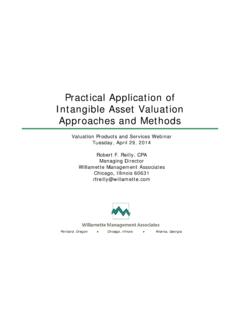Transcription of AS-1: DISCLOSURE OF ACCOUNTING POLICIES
1 AS-1 : DISCLOSURE of ACCOUNTING POLICIES 1 AS-1 DISCLOSURE OF ACCOUNTING POLICIES he objective of financial statements is to provide information about the financial position, performance and cash flows of an enterprise that is useful to a wide range of users, in making economic decisions. TFinancial statements portray the effect of past events and transactions. ACCOUNTING POLICIES and methods adopted by an enterprise, in turn, influence the effect of past events and transactions. Users must be able to compare the: financial statements of any one enterprise through time so that trends and movements in performance and position can be identified, and status of different enterprises for an evaluation of relative financial position and performance.
2 The DISCLOSURE by an entity of its ACCOUNTING POLICIES , enable users to- understand the past extrapolate to the future A critical qualitative characteristic of comparability is that users be informed of not merely the ACCOUNTING principles and methods adopted by the enterprises, but the changes in such POLICIES introduced and the monetary effect of such changes, as well. This standard deals with the DISCLOSURE of significant ACCOUNTING POLICIES followed in preparation and presentation of financial statements. The purpose is to promote a better understanding of financial statements by establishing through an ACCOUNTING Standard (AS), a mandatory requirement that all significant ACCOUNTING POLICIES ought to be disclosed as also the manner in which such ACCOUNTING POLICIES are to be disclosed in the financial statements.
3 ACCOUNTING POLICIES ACCOUNTING POLICIES refer to: a) Specific ACCOUNTING principles, and b) Methods adopted by enterprises, in applying these principles in the preparation and presentation of financial statements. ACCOUNTING Policy Components Principle Method of applying principle Providing depreciation on an Straight line, First Lessons in ACCOUNTING Standards 2 asset to account for loss in value Written down value basis or any other appropriate method DISCLOSURE needs arise because ACCOUNTING POLICIES can differ ACCOUNTING principles and methods can differ between one enterprise and another, in the areas of recognition, treatment or valuation of assets, or recognition of transactions or events.
4 An illustrative list of examples is given below: i. ACCOUNTING conventions followed ii. Basis of ACCOUNTING Historical or Current cost iii. Valuation of inventory iv. Valuation of investments v. Valuation of fixed assets including revaluation vi. POLICIES relating to depreciation of fixed assets vii. Translation of foreign currency transactions or items viii. Treatment of Government grants ix. Treatment of goodwill x. Recognition of a liability for retirement benefits xi. Recognition of profit on long-term contracts xii.
5 Absorption of costs incurred on research and development xiii. Treatment of preliminary, or, capital issue expenses xiv. Treatment of Lease rental income or lease rental payment xv. Treatment of expenditure during construction xvi. Treatment of contingent liabilities Fundamental ACCOUNTING Concepts AS-1 highlights three important practical rules. [The term rules is used consciously to focus on the fact that over time, these are capable of variation and evolve as the depth and profundity of ACCOUNTING practice increases].
6 Going Concern Concept We apply this concept on the basis that the reporting entity is normally viewed to be continuing in operation in the foreseeable future, and without there being any intention or necessity for it to either liquidate or curtail materially its scale of business operations. Accrual Concept This is relevant in the area of revenue and costs. These are accrued, , recognised, as they are earned or incurred (and not as cash is received or paid). Also, they are recorded in the period to which they relate. Consistency Concept There should be consistency of ACCOUNTING treatment of comparable (similar) items, not only within each ACCOUNTING period, but also from one period to another.
7 AS-1 : DISCLOSURE of ACCOUNTING POLICIES 3 These concepts, which are fundamental to ACCOUNTING , are the broad-based assumptions, underlying preparation of financial statements periodically. Financial statements are assumed to be prepared by adhering, among others, to these concepts. Unless any contrary position is unequivocally brought to notice, the user can validly presume that these principles have been followed. Consequently, if any one of these principles is not adhered to, such a fact ought to be disclosed. Selection of appropriate ACCOUNTING POLICIES Financial statements ( , annual accounts) are internationally recognised as a composite whole with, Balance Sheet, Statement of Profit and Loss, Notes on accounts, and cash flow picture, as its constituent elements.
8 Entities governed by the provisions of Companies Act, or other Statutes while complying with the detailed provisions in the relevant statues, should also ensure that the accounts do give a true and fair view of the financial position and performance. A remote possibility of a conflict between compliance with detailed provisions in the Statues and the achievement of truth and fairness cannot perhaps be taken as entirely non-existing. In such a situation, there is an overriding obligation to provide a true and fair view to users of financial statements.
9 It is this overriding obligation that constitutes the major consideration in the determination and selection of ACCOUNTING POLICIES that are appropriate to an entity, event or transaction. Rightly, therefore, AS-1 lays emphasis on true and fair view being kept in primary focus for adoption of any ACCOUNTING policy. Consider an entity using projector lights, the useful life of which is governed by the number of hours it is in use. The basis for an appropriate ACCOUNTING policy for depreciating such an asset would be the actual number of hours such an asset is put to use.
10 Selection of a straight-line method, allowing for a five-year life would apparently be inappropriate. Consider another case of usage of a machinery wear and tear of which is higher in initial years, relative to later years. Selection of written down value method of depreciation would be appropriate in this case, as opposed to a straight-line method. Viewed in this backdrop, true and fair principle would get vitiated if the ACCOUNTING policy selected is inappropriate. An enterprise has, therefore, to exercise scrupulous care in the selection and application of ACCOUNTING principles and methods.





